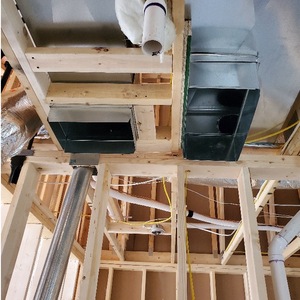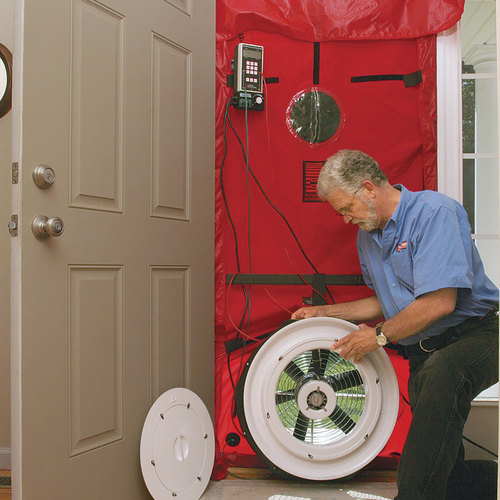
There are two ways to seal potential air leaks in homes: You can either seal seams that you anticipate will leak, or you can seal leaks that become evident when a blower door is used to depressurize the house. This second method of air sealing is known as “blower-door-directed air sealing.”
Blower-door-directed air sealing is a method that was developed in the 1980s by weatherization specialists supported by the Weatherization Assistance Program (WAP), a 42-year-old federal agency that funds air-sealing and insulation work in the homes of low-income families.
Blower-door-directed air sealing for new construction
Some builders of new homes perform multiple blower door tests at each home they build, using each blower door test as an opportunity to improve on the previous results. More commonly, a builder will arrange for a single blower door test, to be performed as soon as the home’s primary air barrier is complete.
If a house has a vented unconditioned attic, the primary air barrier usually includes the wall sheathing and the ceiling drywall. Assuming that the drywall contractor can visit the job site to install the ceiling drywall early in the construction process, the blower door test is performed as soon as the following steps are complete: the wall sheathing, roof sheathing, roofing, windows and doors, and ceiling drywall. (If your airtightness target is ambitious, you might conduct a second round of blower-door-directed air sealing after the electrical and plumbing rough-in, wall insulation, and drywall work is complete.)
If the house has an unvented conditioned attic, the first (perhaps only) blower door test would be performed as soon as the wall sheathing, roof sheathing, roofing, windows, and doors are installed.
If a builder simply wants to know the home’s air leakage rate, the blower door operator sets up quickly, determines cfm at…
Weekly Newsletter
Get building science and energy efficiency advice, plus special offers, in your inbox.

This article is only available to GBA Prime Members
Sign up for a free trial and get instant access to this article as well as GBA’s complete library of premium articles and construction details.
Start Free TrialAlready a member? Log in














15 Comments
This might be a silly question but could a fog machine be used by going room-to-room with it and seeing where the fog goes?
Imeson,
Q. "Could a fog machine be used by going room-to-room with it and seeing where the fog goes?"
A. If you are using a fog machine to find leaks, it's usually easier to do the entire house at once rather than trying to do just one or two rooms at a time. If you want to just do a portion of the house instead of the whole house -- which might be the case if the house was very large -- you would need to compartmentalize the house by temporarily installing sealed polyethylene at the door openings between the compartments before starting the test.
As Trevor Lambert noted, a blower door is used to pressurize the house when conducting a fog test. For more information on fog tests, see "Pinpointing Leaks With a Fog Machine."
This might work, but I think you'd need to pressurize the house, rather than depressurize.
2 other silly questions:
1. why would one do (even the first of two) blower door before plumbing and electrical trades have done their thing, given that their work could cause increased air leakage? What is the advantage of doing it so early?
2. I've read the articles on internal vs exterior air barriers but I am wondering- using an external air barrier- still need to create an "internal" piece to take care of attic ceiling. What "connects" that internal drywall or membrane air barrier to the external part of the air barrier?
Thanks,
Asaf
Asaf,
Q. "Why would one do (even the first of two) blower door before plumbing and electrical trades have done their thing, given that their work could cause increased air leakage? What is the advantage of doing it so early?"
A. Every builder needs to decide the level of seriousness with which to focus on air sealing. Some builders (notably Passivhaus builders) have a very stringent airtightness target, and need to develop a focused plan to make sure they reach their goal. Other builders don't aim so high -- all they want to do is meet minimum code requirements, so they're not really interested in tracking down every last leak.
The main reason a builder might want to schedule two blower door tests is because it's advantageous to seal certain leaks before the walls are closed up and the leaks become inaccessible. For example, if you are building a house with 2x6 walls that will be insulated with fiberglass batts -- admittedly an unusual choice if you are a GBA reader -- you may want to schedule a blower door test before the walls are insulated, to see whether there are lots of sheathing leaks that need to be addressed. Once the drywall is installed, these sheathing leaks become harder to seal.
Admittedly, this first blower door test should probably be performed after the electricians and plumbers have finished their rough-in work, but before the drywall is installed. That said, once the primary air barrier is installed, you can perform your first blower door test if you want. The second blower door test (if there is one) might be scheduled after drywalling is complete.
Testing twice is especially valuable for builders who are just learning about air sealing. If you've got three or four houses under your belt -- houses that have already tested at 1 ach50 or better -- you probably have the confidence to proceed with a single blower-door test -- because you've learned about airtight construction techniques, and you can now avoid common mistakes.
Asaf,
Q. "What connects the internal drywall or membrane air barrier to the external part of the air barrier?"
A. Usually, a piece of plywood or OSB, installed above the top plate of the exterior walls. This plywood or OSB is wider than the top plate, and it cantilevers into the interior of the house so that it can be sealed to the drywall ceiling. For more information on this approach, see "A Practical Air-Sealing Sequence."
Asaf, the approach Martin shows is ideal for strapped ceilings, as we do normally in the northeast, especially with double-stud walls where you want something to tie the walls together anyway. Another method is to run an airtight membrane over the top plate before setting rafters or trusses, a flexible strip taped to the inside of the sheathing. A third method is to seal the top plates to the sheathing with a high-quality adhesive such as Locktite's PL Premium polyurethane construction adhesive, run tape around the joints in the top plate, and seal your ceiling's air barrier to the top plate with tape or adhesive. Each method has pros and cons.
I am not an expert on blower door testing but have used it in both new construction and energy use reduction upgrades. If one is going to test before drywall and is using a warm side Membrane or the like, blower door pressurization of the building may work best. Warm side flexible air barriers tend to pull away from seams and sealants when depressurizing at 50 Pascals. It would be easy to spot and mark leaks when using smoke or fog with pressurization of the building.
I'm wondering how good is drywall as an air barrier since eventually it gets nail holes and such from people hanging pictures etc. Of course these tiny holes are nothing compared to the gap around an electrical box, but are they something to be concerned about over the long haul? I'd expect they'd be trivial, but I've been surprised before.
Dennis,
These days, use of the Airtight Drywall Approach (ADA) is fading in favor of making the primary air barrier at the wall sheathing. The classic way to implement a sheathing-side air barrier is with taped Zip sheathing.
Some Passivhaus builders share your worry, and advocate the use of an interior air barrier of OSB with taped seams, protected by a 2x4 service cavity on the interior side of the OSB air barrier. (This last approach is sometimes criticized by those who note that some brands of OSB aren't airtight.)
Frankly, I'm not too worried by the idea of tiny holes in drywall from people hanging pictures -- after all, most of these holes are fairly well sealed by the tiny fasteners used to hang the pictures. As for tiny holes without any fasteners -- they are pretty rare, and as you point out, not as leaky as the typical electrical box.
Thanks Martin for the answer regarding airtight drywall (ADA). A few comments back you had mentioned sealing the sheathing to the ceiling drywall. With that comment combined with reading GBA religiously for months, I would have never guessed that ADA was falling from favor. This is surprising news to me. So it seems you're saying that drywall may often be part of the air barrier, but usually not the entire drywall envelope.
Dennis,
While the airtight drywall approach is rarely used these days as the primary air barrier for walls in a new house, drywall is still airtight. It always has been and always will be.
For ceilings rather than walls, drywall remains the most common material used as an air barrier.
If you are choosing an air barrier for your own project, your decisions don't have to be based on a popularity contest. Ultimately, it doesn't really matter what method is used by the builder next door. If you have a method that works for you -- and you have the blower-door results to prove that it works -- you should continue with your favored method.
I'd agree that a popularity contest is certainly not the basis for choosing an air barrier. However there are reasons for the popularity, be it price, ease of construction, effectiveness etc. As for me I think I'll still go for airtight drywall in addition to airtight sheathing. I can't see where redundant layers would hurt.
“[Deleted]”
I’ll be shooting for Net Zero Ready. 2x6 walls with Rockwool (r-23) and Zip R9, R -60 cellulose in the attic with 20” energy heel trusses. I’ve been reading and researching a lot in the past several months, but I’m having trouble figuring out one thing at the moment. How do you seal the ceiling drywall after rough-ins are complete? I’ll be using something like 10” Zip Flashing Tape to connect the zip R9 up, over, and down the top plate (unless someone can recommend a better solution there - I won’t be using furring strips so using osb is out). Then, I was going to use Great Stuff Flexible Foam Drywall Gasket on the sides of all the top plates prior to installing the interior drywall on the walls…. But until the that’s done, won’t there be leaks at every single top plate - interiors and exteriors - causing a terrible ACH50 score? If so, what am I missing? If not, what am I missing? 😂
Log in or become a member to post a comment.
Sign up Log in